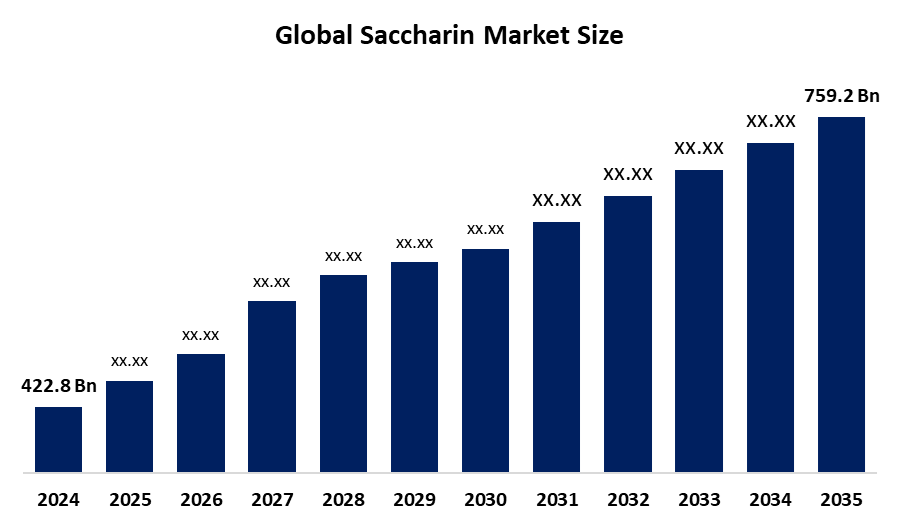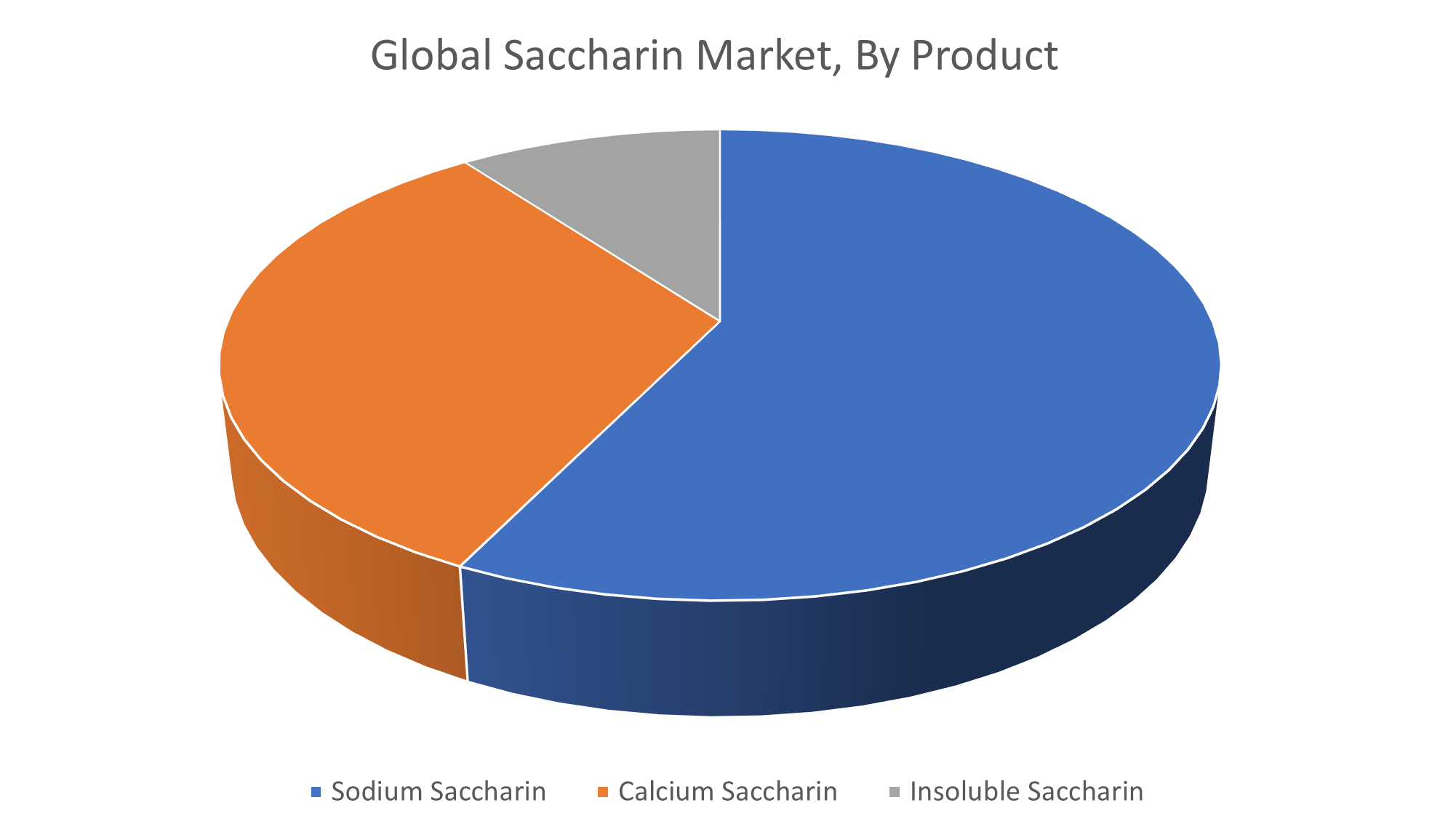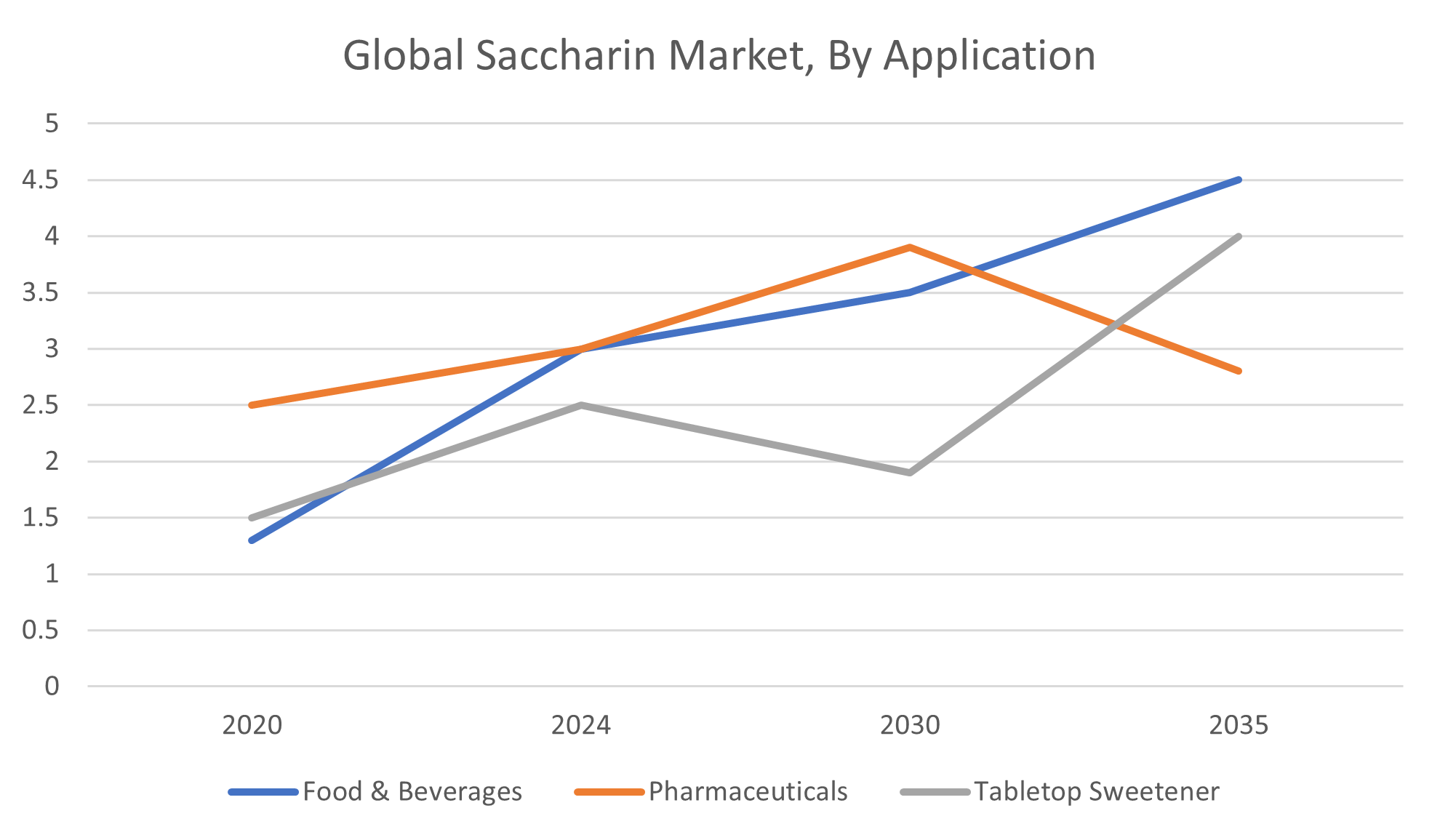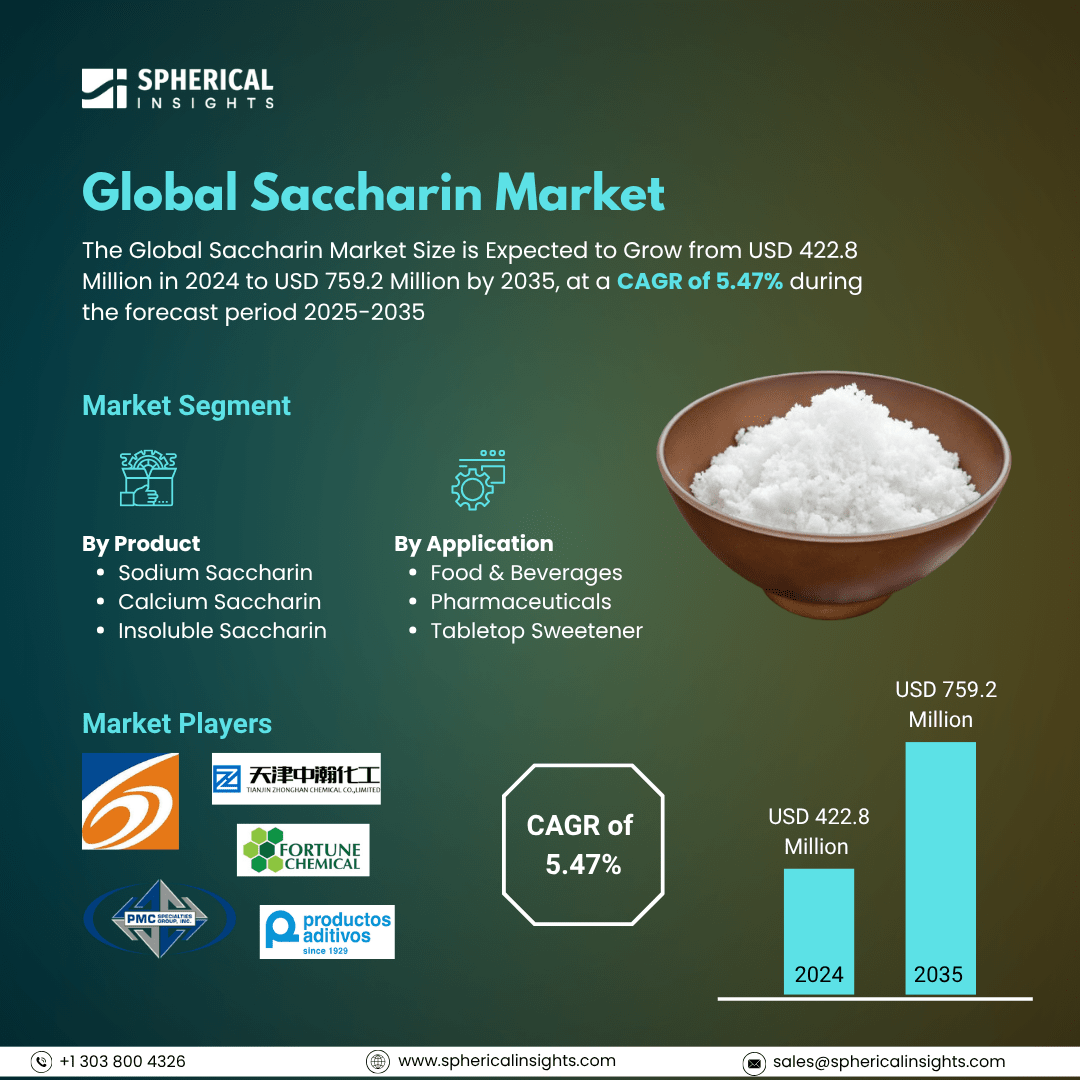Global Saccharin Market Insights Forecasts to 2035
- The Global Saccharin Market Size Was Estimated at USD 422.8 Million in 2024
- The Market Size is Expected to Grow at a CAGR of around 5.47% from 2025 to 2035
- The Worldwide Saccharin Market Size is Expected to Reach USD 759.2 Million by 2035
- Asia Pacific is expected to grow the fastest during the forecast period.

Saccharin Market
The global saccharin market encompasses the production and distribution of saccharin, a non-nutritive artificial sweetener widely used as a sugar substitute. Saccharin is significantly sweeter than sugar and contains no calories, making it suitable for a variety of applications. It is commonly used in the food and beverage industry for products such as diet drinks, baked goods, and confectionery, as well as in pharmaceuticals, personal care products, and animal feed. The market includes various forms of saccharin, including sodium saccharin, calcium saccharin, and insoluble saccharin, each used based on specific industrial requirements. The Asia-Pacific region holds a leading position in global production and consumption, with China being a major player. North America and Europe also maintain a steady demand due to regulatory approvals and widespread usage across multiple industries. Overall, the global saccharin market continues to grow, supported by its established role across several commercial and consumer product categories.
Attractive Opportunities in the Saccharin Market
- Rapid urbanization, increasing disposable incomes, and an expanding middle class in regions like Asia-Pacific are creating substantial demand for saccharin-containing products. Countries such as China and India are witnessing robust industrial growth and evolving consumer preferences, making these regions hotspots for market expansion and investment.
- Increasing regulatory approvals and positive safety assessments worldwide help reinforce consumer confidence in saccharin. Focused consumer education initiatives can further alleviate residual safety concerns, encouraging wider acceptance and sustained market growth.
Global Saccharin Market Dynamics
DRIVER: The rising number of health issues like obesity and diabetes
Saccharin is becoming more popular as people look for healthier alternatives to sugar. One of the main reasons for the growth of the saccharin market is the rising number of health issues like obesity and diabetes, which are pushing consumers to choose low-calorie and sugar-free products. Saccharin is much sweeter than sugar but has no calories, making it a good option for foods, drinks, and medicines. It is also cheaper than many other sweeteners, which helps companies save on production costs. Its ability to stay stable under heat and in acidic conditions makes it useful in a wide range of products, including baked goods, soft drinks, and even toothpaste and mouthwash. Approval from health authorities in different countries has also made people more confident in its safety.
RESTRAINT: Growing preference for natural sweeteners like stevia and monk fruit, which are viewed as cleaner, plant-based options and are gaining popularity among health-conscious consumers
While saccharin continues to find wide applications, several challenges are restraining its market growth. One significant issue is the lingering public concern over its safety, stemming from early studies that linked saccharin to potential health risks. Despite regulatory approvals confirming its safety, this historical controversy has affected consumer perception in some regions. Another key restraint is the growing preference for natural sweeteners like stevia and monk fruit, which are viewed as cleaner, plant-based options and are gaining popularity among health-conscious consumers. Saccharin also faces regulatory hurdles in certain countries, where strict labeling and usage limits can complicate product formulation and marketing. In addition, the slightly bitter aftertaste of saccharin can reduce its appeal in products requiring a neutral or smooth flavor profile. Environmental concerns related to its synthetic production process and fluctuations in chemical input costs may further impact market stability.
OPPORTUNITY: Expanding pharmaceutical and personal care sectors also offer promising avenues
Growing awareness about sugar-related health issues is encouraging food and beverage manufacturers to develop more low-calorie and sugar-free products, creating a rising demand for saccharin as an effective sweetening agent. The expanding pharmaceutical and personal care sectors also offer promising avenues for saccharin use, especially in products like toothpaste, mouthwash, and cough syrups. Emerging markets in Asia-Pacific and Latin America present considerable growth potential due to increasing urbanization, rising disposable incomes, and expanding middle-class populations. Innovations in formulation technology could help reduce saccharin’s bitter aftertaste, improving its acceptance in a broader range of products. Furthermore, partnerships between saccharin producers and food manufacturers can lead to new applications and product development. As regulatory bodies continue to support its safe use, saccharin is well-positioned to capitalize on the global trend toward healthier, low-calorie lifestyles, driving market expansion in the coming years.
CHALLENGES: Complexity of navigating diverse regulations across different countries
Despite official approvals confirming its safety, consumer doubts stemming from past controversial studies continue to affect its reputation. This is further compounded by the growing popularity of natural sweeteners like stevia and monk fruit, which are often seen as healthier and more eco-friendly alternatives. Saccharin’s slightly bitter aftertaste also restricts its use in flavor-sensitive products. Moreover, the complexity of navigating diverse regulations across different countries creates obstacles for manufacturers in terms of compliance and distribution. Environmental concerns linked to its synthetic production process and fluctuating raw material prices add additional pressure on producers. To overcome these barriers, companies must focus on improving taste, adopting greener production methods, and enhancing consumer education to rebuild confidence and maintain saccharin’s relevance in the competitive sweetener market.
Global Saccharin Market Ecosystem Analysis
The global saccharin market ecosystem involves raw material suppliers, manufacturers/sellers, distributors, regulatory bodies, and end-use industries. Raw materials are processed by manufacturers, mainly in Asia-Pacific, into various saccharin forms for use in food and beverages, pharmaceuticals, personal care, and animal feed. Manufacturers often also act as sellers, supplying products directly or through distributors who connect them with end-use industries. Regulatory bodies ensure safety and quality standards, while consumer demand drives product development and market growth. This interconnected network shapes the overall functioning and expansion of the saccharin market worldwide.
Based on the product, the sodium saccharin segment held the largest revenue share and is expected to grow at a substantial CAGR during the forecast period

The sodium saccharin segment held the largest revenue share in the global saccharin market and is projected to grow at a substantial CAGR during the forecast period. This is largely due to its widespread use across various industries such as food and beverages, pharmaceuticals, and personal care products. Sodium saccharin is favored for its high sweetness intensity, good solubility, and cost-effectiveness, making it a preferred choice among manufacturers. Its stability under heat and acidic conditions further enhances its applicability in diverse formulations. As demand for low-calorie and sugar-free products continues to rise globally, the sodium saccharin segment is expected to maintain strong growth momentum throughout the forecast period.
Based on the application, the food & beverages segment accounted for the highest revenue share and is expected to grow at a remarkable CAGR during the forecast period

Saccharin is widely used as a zero-calorie artificial sweetener in a variety of food and beverage products, including soft drinks, baked goods, confectionery, and dairy items. Its intense sweetness, combined with the ability to remain stable under heat and acidic conditions, makes it ideal for many processed foods. Increasing consumer awareness about the health risks associated with high sugar intake, such as obesity and diabetes, has driven demand for low-calorie and sugar-free alternatives like saccharin. As a result, manufacturers are increasingly incorporating saccharin into their products to cater to health-conscious consumers. This shift towards healthier eating habits and rising demand for diet-friendly food and beverages are expected to propel the growth of the saccharin market within the food and beverages segment over the coming years.
North America is anticipated to hold the largest share of the saccharin market during the forecast period
North America is anticipated to hold the largest share of the saccharin market during the forecast period. This dominance is attributed to the region’s well-established food and beverage industry, high consumer awareness regarding health and wellness, and widespread demand for low-calorie and sugar-free products. Additionally, strong regulatory support and approvals from agencies such as the FDA provide a favorable environment for saccharin use in various applications. The presence of major manufacturers and easy access to advanced technologies also contribute to North America’s leading position. Growing trends toward healthier lifestyles, combined with increasing cases of diabetes and obesity, further drive the demand for saccharin as a sugar substitute.
Asia Pacific is expected to grow at the fastest CAGR in the saccharin market during the forecast period
Asia Pacific is expected to grow at the fastest CAGR in the saccharin market during the forecast period. This rapid growth is driven by factors such as increasing urbanization, rising disposable incomes, and expanding middle-class populations in countries like China and India. The region’s large and growing food and beverage industry, along with increasing health awareness among consumers, is boosting demand for low-calorie and sugar-free products containing saccharin. Additionally, the presence of numerous manufacturers and suppliers in Asia Pacific, especially in China, supports the market’s expansion. Favorable government initiatives and improving regulatory frameworks also encourage the use of saccharin in various applications. As a result, Asia Pacific is poised to be the fastest-growing market, offering significant opportunities for saccharin producers and end-users during the forecast period.
Key Market Players
KEY PLAYERS IN THE SACCHARIN MARKET INCLUDE
- Kaifeng Xinghua Fine Chemical Ltd.
- Tianjin Changjie Chemical Co., Ltd.
- PMC Specialties Group, Inc.
- Tianjin North Food Co., Ltd.
- Shanghai Fortune Chemical Co., Ltd.
- Shanghai Merry Yang Enterprise Co., Ltd.
- Productos Aditivos S.A.
- Vishnu Chemicals Limited
- Blue Circle Organics Pvt. Ltd.
- Shree Ganesh Chemicals
- Salvi Chemical Industries Ltd.
- Kyung-In Synthetic Corporation (KISCO)
- Others
Market Segment
This study forecasts revenue at global, regional, and country levels from 2020 to 2035. Spherical Insights has segmented the saccharin market based on the below-mentioned segments:
Global Saccharin Market, By Product
- Sodium Saccharin
- Calcium Saccharin
- Insoluble Saccharin
Global Saccharin Market, By Application
- Food & Beverages
- Pharmaceuticals
- Tabletop Sweetener
Global Saccharin Market, By Regional Analysis
- North America
- Europe
- Germany
- UK
- France
- Italy
- Spain
- Russia
- Rest of Europe
- Asia Pacific
- China
- Japan
- India
- South Korea
- Australia
- Rest of Asia Pacific
- South America
- Brazil
- Argentina
- Rest of South America
- Middle East & Africa
- UAE
- Saudi Arabia
- Qatar
- South Africa
- Rest of the Middle East & Africa






